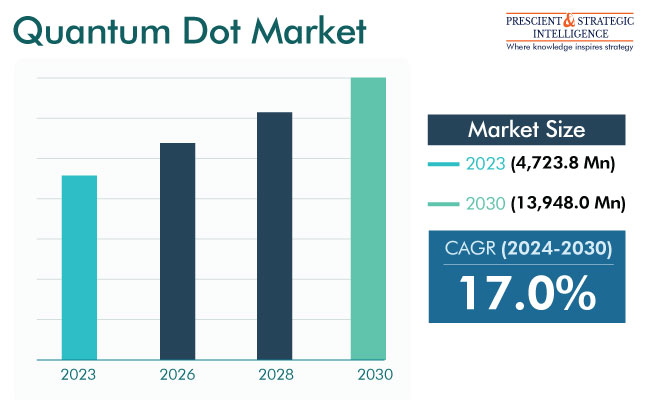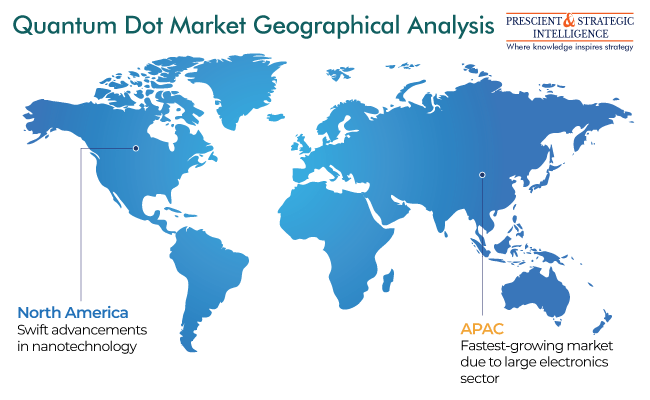Report Code: 10164 | Available Format: PDF
Quantum Dots Market Revenue Forecast Report: Size, Share, Recent Trends, Strategic Developments, Segmentation Analysis, and Evolving Opportunities, 2024-2030
- Report Code: 10164
- Available Format: PDF
- Report Description
- Table of Contents
- Request Free Sample
Market Overview
The quantum dots market revenue is estimated at USD 4,723.8 million in 2023, and it will advance at a CAGR of 17% during 2024 to 2030, to reach USD 13,948.0 million by 2030. The adoption of the quantum dots technology is due to the growing demand for devices that have improved performance and better resolution quality. Moreover, the electronics sector’s growing demand for narrow-band light frequency and the increasing R&D on such materials drive the market.

A quantum dot (QD) is a semiconductor nanocrystal with a reactive core, which regulates its optical properties. The shrinkage of the semiconductor material to the quantum-dot level helps in altering the light wavelength and converts the material from an insulator to conductor. Hence, it serves as a multipurpose tool in various sectors, which is the key reason behind the market growth.
With the increasing use of electronic gadgets, such as mobile phones and tablets, the demand for better display and resolutions arises, which drives the market growth. Quantum dots are also required in the security & defense and food & packaging sectors.
Most-Widely Used Material for Quantum Dots Are Based on Cadmium
The cadmium-based category holds the larger share, based on material. QDs that contain cadmium have various advantages, such as high photostability, bright photoluminescence, broad ultraviolet excitation, and narrow emission. This is why they can be used in electroluminescence & photovoltaic devices, sensors, catalytic hydrogen production, and bio-imaging.
Among the various types of quantum dot materials that fall in this broad class, cadmium selenide (CdSe) has been extensively studied for application in fluorescent semiconductor nanocrystals. This is due to its capability to offer a suitable and adjustable bandgap across the visible spectrum. CdSe is renowned for its consistent and uniform size distribution, thus making it highly versatile.
Cadmium-Free Materials Are Rising in Popularity
Over the forecast period, the cadmium-free category is expected to witness a robust CAGR. Cadmium-free quantum dots provide environmentally sustainable and safer alternatives for both manufacturers and consumers. They offer the color benefits linked with the quantum dot technology without the risks of toxicity or regulatory constraints. Cadmium-free quantum dots are not limited to display applications, as they are also used in various other fields, such as solar cells, biomedical applications, and lighting solutions.
The use of cadmium is restricted in many countries as it is harmful to humans and the environment. The European Union’s official journal has issued rules prohibiting the use of household products that contain cadmium, and the European Commission is focusing on removing it. To manufacture cadmium-free QDs, silicon and graphene are being increasingly used. In the field of healthcare, the surgeon can differentiate between healthy and sick tissue by employing cadmium-free QDs to illuminate the chemicals attached to the tumor.
| Report Attribute | Details |
Market Size in 2023 |
USD 4,723.8 Million |
Revenue Forecast in 2030 |
USD 13,948.0 Million |
Growth Rate |
17.0% CAGR |
Historical Years |
2017-2023 |
Forecast Years |
2024-2030 |
Report Scope |
Market Trends, Drivers, and Restraints; Revenue Estimation and Forecast; Segmentation Analysis; Impact of COVID-19; Companies’ Strategic Developments; Market Share Analysis of Key Players; Company Profiling |
Explore more about this report - Request free sample
Growing Demand for Display Devices Is Strong Market Driver
On the basis of application, the displays category generates the highest revenue in the market. QDs are used by the manufacturers of display devices as they have high stability, a narrow spectrum, and low power consumption. QDs are widely used in digital cameras, displays of flat-panel TV screens, smartphones, personal digital assistant devices, and gaming consoles.
Quantum-dots light-emitting diodes (QLEDs) stand out from LCDs, OLEDs, and plasma displays by providing a distinctive combination of exceptional brightness, long operational life, and high efficiency. QLEDs displays have a longer life than LCD ones, attributed to the former’s modern technology and lower susceptibility to degradation over time. Furthermore, QLEDs can be made rather thin, flexible, and transparent. They are also energy-efficient and cost-effective to manufacture, thus attracting the attention of the significant display manufacturers.
The rise in the rate of urbanization has led to the increasing sales of smart TVs, which are predicted to surge further with the escalating per capita income. The demand for high-performance, premium screens has propelled companies to embrace the latest technologies to enhance the overall end-user experience. LED backlighting is enhanced in LCD TVs by incorporating a quantum dot enhancement film (QDEF) layer. By utilizing quantum dots, the intermediate colors can be eliminated, thus resulting in the generation of pure colors and an expanded color spectrum, which also enhances energy efficiency.
The demand for electronic devices with better resolutions and a narrower band of frequency of light will further increase the demand for the QD technology, thereby fueling the market growth in the coming years.
QDs Are Widely Used in Generation of Solar Energy
In April 2022, UbiQD partnered with SWM International to create advanced quantum dot interlayers for power-generating windows. These interlayers, using the luminescent solar concentrator technology, absorb sunlight and convert it to near-IR light, which is ultimately harvested into electricity. This innovation could help in meeting the U.S. Department of Energy's goal to reduce electricity use in buildings. Infrastructure consumes 76% of the electricity in the country, thus accounting for a large share of indirect emissions.
Quantum dots are also employed as a photovoltaic component within a solar cell, in which case the assembly is referred to as a quantum-dot solar cell (QDSC). QDs are used to replace bulkier materials, such as silicon and copper–indium–gallium selenide. QD solar cells possess the capability to harness hot photogenerated carriers, thus allowing for the generation of greater photocurrents and higher photovoltages and resulting in grayscale depth. This enhanced functionality contributes to increasing the maximum solar photon conversion’s thermodynamic efficiency to about 66%.
Highest Revenue Is Generated by Bulk Manufacturing
The bulk manufacturing technology category dominates the market as it has the ability to produce QDs on a large scale with an enhanced quality. It is suitable for meeting the high demand for these materials in various applications, such as consumer electronics, displays, and solar panels. The benefits of bulk manufacturing include cost-efficiency, as it reduces the production cost per unit volume; mass adoption, supply consistency, and enhanced product performance.
The cadmium-free QD technology is expected to experience the second-highest rate of growth. This is primarily due to its applicability in consumer-oriented products, where the usage of cadmium is restricted or regulated.
Some of the Global Players in Quantum Dots Technology Are:
- QD Vision Inc.
- Quantum Materials Corporation
- Nanosys Inc.
- QD Laser Inc.
- Nanoco Group PLC
- InVisage Technologies Inc.
- Ocean Nanotech LLC
- NN-LABS LLC
- Merck KGaA
- LG Display Co. Ltd.
- Samsung Electronics Co. Ltd.
- Sony Group Corporation
- OSRAM Licht AG
Consumer Electronics Hold Largest Share
Consumer electronics companies are increasingly incorporating QDs into their products due to the technology's potential to increase the display performance. Quantum dots offer several other benefits, including reduced power consumption and improved color accuracy. They are also known for their pure color output, high brightness, and wavelength adjustability, enabling display designers to customize the light spectrum for optimal color performance and efficiency. Therefore, the consumer segment is expected to be the largest end user in the market during the projection period.
Highest Growth Rate Expected in Asia-Pacific
In the future, the highest CAGR in the market will be seen in the Asia-Pacific region. This can be attributed to the shifting customer focus toward advanced technologies and the active engagement of numerous universities and organizations in research and development on QDs for display applications. Further, there would be a surge in the Asian-Pacific market value as the region offers the advantage of cost-effective manufacturing. This can be attributed to the existence of a large population of price-sensitive customers and major electronics companies, such as Samsung, Sony, and LG.

Additionally, the market advance is attributed to the growing usage of solar energy and optoelectronics. QDs are a preferred material for displays and lighting products as they offer a high quantum yield, emission tenability, visual stability, and narrow emission band.
Want a report tailored exactly to your business strategy?
Request CustomizationWant an insight-rich discussion with the report author?
Speak to AnalystOur dedication to providing the most-accurate market information has earned us verification by Dun & Bradstreet (D&B). We strive for quality checking of the highest level to enable data-driven decision making for you
Our insights into the minutest levels of the markets, including the latest trends and competitive landscape, give you all the answers you need to take your business to new heights
With 24/7 research support, we ensure that the wheels of your business never stop turning. Don’t let time stand in your way. Get all your queries answered with a simple phone call or email, as and when required
We take a cautious approach to protecting your personal and confidential information. Trust is the strongest bond that connects us and our clients, and trust we build by complying with all international and domestic data protection and privacy laws